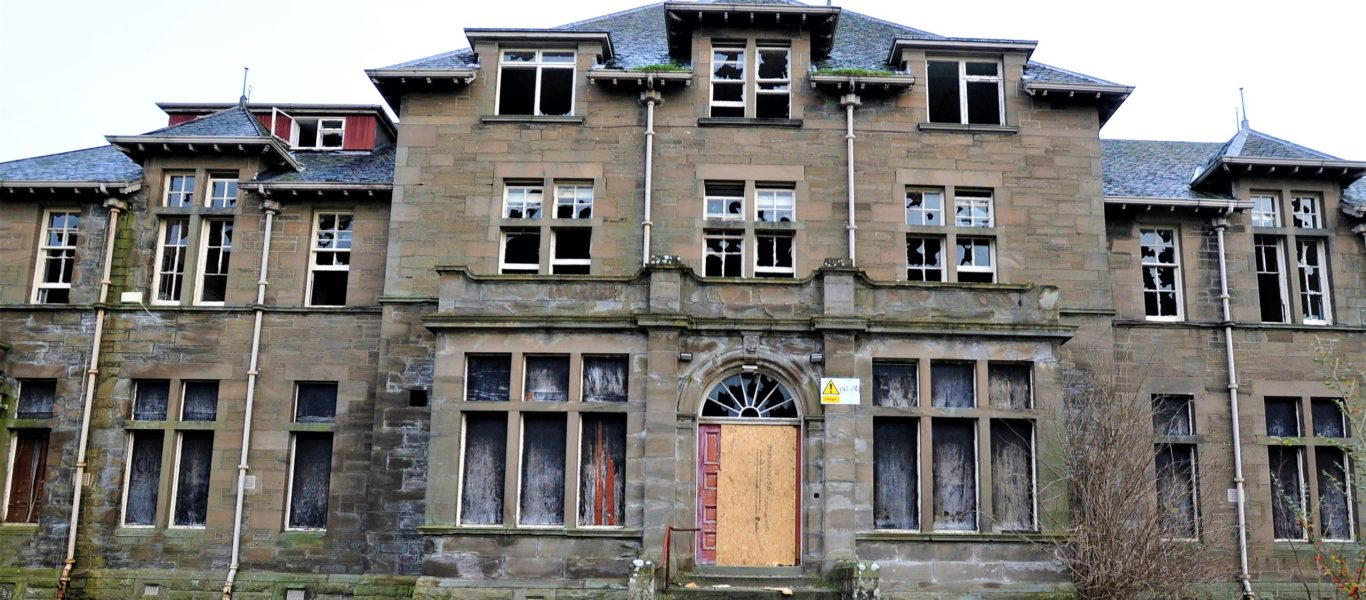Ryden’s Planning team has just delivered the latest in a series of permissions for a major new redevelopment of the listed former Strathmartine Hospital site in Angus.
It is the culmination of a journey that has taken over a decade in taking a site with limited potential and policy support through Planning Permission in Principle to delivery of a final detailed approval.
The case provides an insight into the complexities of the planning process and the barriers to delivering permission for a sound basic proposal.
The former Baldovan Institute – Strathmartine Hospital site extends to 42 acres and lies within Angus Council area and is situated just across the administrative boundary of the Doughty Burn on the north side of Dundee.
It is a typical former NHS site – sprawling Listed Buildings in a mature landscape setting.
Over the years the buildings have decayed, aided in no small part by theft of lead, successive fires and arson, and general vandalism. Over that time the landscape has become unkempt and overgrown. The last decade of storms and winters has done the rest.
As a planning case study, it has had everything and the kitchen sink in its way.
Original policy representations were made (by others) that redevelopment of the site could be cross financed by up to 40 new residential units including conversion of the Listed Buildings.
Robert Evans, Partner of Ryden who is Head of the Planning Consultancy Group has been involved in the site since that time. Initially, his review concluded that significantly more than the ‘up to 40’ threshold would be required for the site to wash its face particularly due to the condition and configuration of Listed Buildings, the topography of the site and the other policy requirements for contributions for education and affordable housing. Even at that stage, it was looking more like up to 250 units.
A development strategy involved retention and conversion of core Listed Buildings and demolition of much of the remainder of the site. New apartments ( in 12 town houses) would be provided in the main original blocks, the setting of the buildings improved and a range of clusters of 184 private new build and 28 affordable units provided across the estate in a high quality landscape setting.
An application for Planning permission in principle was submitted following formal Pre Application Public Consultation and collation and co-ordination of a full Environmental Impact Assessment.
The public consultation responses were split between young families desperately wanting to see new housing and support for community services and infrastructure, and those wishing to protect everything and build nothing (or at best very little).
This stage also included several iterations of commercial viability based on changing circumstances related to deteriorating building conditions (largely as a result of the fires) and changing economics of build costs and sales values and contributions required for affordable housing and education. Tactically, a holistic approach was therefore required.
The original application was contrary to development plan policy (due to the number of units proposed) and despite the odds, was approved by the full council against officer’s recommendations.
The presentation to full council included a telling video loop of the site and a telling narrative that appealed to key councillors that if the unit numbers were not specified by the plan the application would be completely consistent with it. To their credit since then, officers have been supportive but have still strictly adhered to all other policy requirements.
Education capacity and provision for both primary and secondary classes has ebbed and flowed before reaching agreement on the level of contributions.
Similarly the dance around affordable provision eventually ended up with half on site and half paid as a commuted sum for off-site provision.
However, celebration was short-lived. The same full council meeting also refused a number of other applications and we soon found ourselves part of a judicial review process – even though no permission had been issued (simply a resolution subject to a S75) and that our case was based on a windfall site not a housing land allocation argument.
Eventually the latter point was accepted and our case was released from court proceedings.
Again, that relief was short-lived. The Scottish Government decided to Call in the Application based on an outstanding objection from the neighbouring Dundee Council (on the basis it would impact land supply in their market area and that the site was unsustainable).
An appeal process followed and the appointed reporter found in our favour and recommended the application be approved. A recommendation that was supported by Ministers and a minded to grant decision was issued.
But still no time for celebration. The next step of the process became a protracted negotiation with NHS on the basis of a Clawback Clause in the contract of sale. Some clumsy historic wording had an unintended consequence of returning half the uplift in value of any development whatsoever over the site as opposed to an established baseline upon which the original purchase price was paid.
So the finely balanced economic appraisal of construction costs associated with significant demolitions, site remediation, converting listed buildings and the financial impact of education and affordable requirements was again revisited – but the development simply didn’t stack up.
Despite every effort in re-appraising the clawback and contributions required, the unintended final outcome was time expiry of the contractual obligation.
The lack of conclusion on this issue had prevented a S75 Obligation from being drafted and signed and therefore no permission was issued.
Legal Opinion was sought and both the applicant and Angus Council agreed that there was no lawful impediment to the issuing of a planning permission subject to a suspensive condition that required a S75 to be agreed.
Scottish Government therefore took the unusual step of granting permission subject to such a condition requiring a legal agreement.
That really helped in providing certainty that permission was granted and focussed all concerned on concluding the agreement.
More recent process to amend the terms of a planning condition and the very recent approval of an Application for Matters Specified by Condition now means that finally, a permission involving the rehabilitation and conversion of Listed Buildings and redevelopment of the whole site can proceed.
Throughout the process, based on the initial application and EIA – the statutory consultation responses, including Historic Environment Scotland have all offered no objection.
The basic policy premise was that a defined quantum of development would be required to help deliver the conversion of Listed Buildings following the closure of the hospital.
However, that quantum was not realistic. Because the limit of new housing was defined, the original application was not complaint with policy. Had the policy simply stated its objective of delivering the conversion and re-use of the site on the basis of the minimum amount of development required to deliver a viable proposal then there would have been far fewer obstacles to navigate.
Planning policy was overly prescriptive, negatively written and restrictively interpreted and each stage of the process was met by a reason to delay, oppose or reject proposals.
At the end of the day, we have succeeded. Although a decade later buildings are in worse condition and more perilous state and the site more decrepit and overgrown, the permission is for about the same number of houses that we initially thought would be required to balance the books (depending on the level of contributions sought).
The system was stacked against this site yet councillors accepted the merits of it 7 years ago.
A permission still needs to be delivered on the ground to provide new homes, support local services and convert historic buildings.
Practitioners, applicants and decision makers on all sides should be able to engage early and agree the key steps and outcomes to provide certainty in the planning process.
The site is the loser here, as well as the local community that has been faced with a decaying site on its doorstep.
It would be much better if the focus was on making this happen rather than looking for reasons to prevent things happening. Applicants and authorities, officers and agents, and community representatives (both YIMBYs and NIMBYs) should all be able to agree the basic rules of engagement early on.

